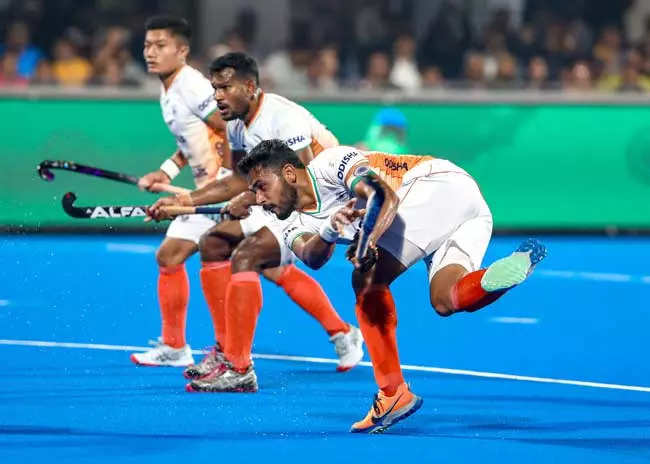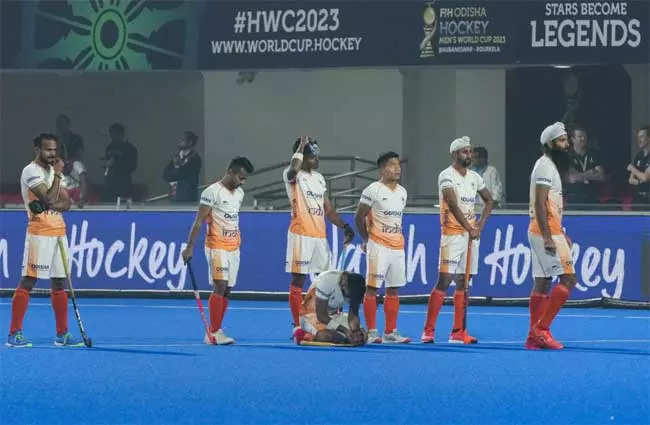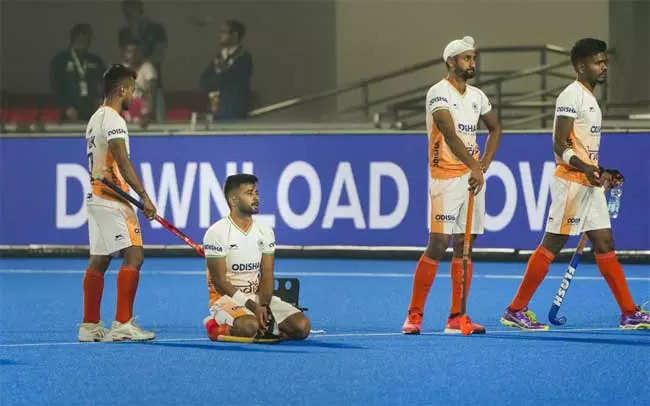
BHUBANESWAR: "Thankfully, I didn't buy tickets for the rest of the games." The disaster that unfolded at the Kalinga Stadium on Sunday night has left a mark that won't easily be erased, if it does at all, from the mind of fans. The above remark on social media by a fan highlights what the sport is at risk of losing after India's World Cup exit outside of the top eight.
Another fan was travelling to Bhubaneswar with his wife and nine-month-old kid to watch India in the quarterfinals of the World Cup when India's struggle and New Zealand's control in the crossover game on Sunday were giving jitters to the family.
"Welcome to Odisha...there's a lot to offer in Odisha beyond hockey," a tweet responding to the family's dismay read.
The fans were basically offering their shoulders to each other to cry on. India lost to New Zealand in sudden death (5-4), after twice leading with a two-goal margin, 2-0 and 3-1. After the regulation time of 60 minutes the scoreboard read 3-3. The ensuing penalty shootout ended at 3-3 as well, solely because of PR Sreejesh's consecutive saves that brought India back from the dead. He saved the first attempt by NZ in sudden death as well, injuring himself in the process. But it gave skipper Harmanpreet Singh a perfect setting to redeem his disastrous World Cup as a player.
Had Harmanpreet scored in sudden death, he would have lifted the mood of the entire country. The fan above would have bought tickets and the young family travelling to watch the World Cup wouldn't have felt disappointed about their decision.

Image credit: Hockey India
But neither coach Graham Reid nor skipper Harmanpreet Singh talked about the 'responsibility' that both had mentioned so emphatically in their addresses to the media before Sunday.
With the benefit of hindsight at their disposal now, the Indian team management must answer these seven questions:
1. Why couldn't India protect a two-goal lead twice in the match?
India's defence never looked organized in just the first knockout game they played at the World Cup. The New Zealanders found easy passage into the Indian circle, especially in the last quarter, when the defenders were spotted waiting for the Kiwi attackers inside the circle, whereas they should have been tackling them outside the D. It was the same mistake India committed in the 2018 Asian Games final against Malaysia. The team lost on both occasions.

PTI Photo
2. Why did the Indian defence buckle under pressure in the last 16 minutes?
It was not that India didn't get possession in the last quarter. But on most occasions when an Indian player got the ball, it took just a few seconds for a NZ player to reclaim it, either through an unforced error or by forcing the Indian players to pass the ball in a hurry when it would have been wiser to hold onto it, spray the ball around and build an attack. That didn't happen, possibly a mental block when in a winning situation in the dying minutes. A similar approach almost cost India dear in the bronze-medal playoff against Germany in the Tokyo Olympics as well.
3. Why were four youngsters asked to handle the pressure of the shootouts?
It was difficult to fathom the decision when skipper Harmanpreet Singh led Rajkumar Pal, Sukhjeet Singh, Shamsher Singh and Abhishek as India's choices for the penalty shootout. Of course, the team decides these things pre-match, which means only coach Graham Reid can answer why the much experienced players like Manpreet Singh (318 matches), Akashdeep Singh (222), Mandeep Singh (198) and Lalit Upadhyay (137) were not among the five when the team was at the edge of a World Cup exit.
4. Why is "creating opportunities" becoming rhetorical in Indian hockey?
It's not that India haven't created chances or didn't have enough shots at goal. The attacking style that the team plays gives them enough opportunities to score, but the numbers around 'circle penetrations' don't take a team anywhere unless the majority of those are converted into goals. The goalless draw in the pool game against England is a classic example in this context. Had India won that game, they would have topped the pool and secured a direct spot in the quarterfinals.
5. Why wasn't the team able to find a solution to their penalty-corner (PC) woes four matches in a row?
It's been one of the biggest talking points of India's sorry campaign, especially since the game against England when the hosts earned eight penalty corners but could convert none. In four matches so far in this World Cup, India have earned 26 PCs and scored off only five. The sad part is that only twice India's direct drag-flicks found the mark, once against Wales when the visitors had withdrawn their goalkeeper, which is also drag-flick expert Harmanpreet's only goal so far. And second when Varun Kumar sounded the board against New Zealand. Such have been Harmanpreet's woes off drag-flicks in this World Cup that he missed a penalty stroke as well against Spain.

PTI Photo
6. What exactly were Bram Lomans's inputs in the camp conducted for India's penalty-corner experts last December?
Ironically, the Netherlands' drag-flick expert Bram Lomans was brought in by Hockey India to conduct a camp for the Indian drag-flickers a month before the World Cup. What the inputs were for Indian players during that week-long camp is another question that's waiting for an answer, specifically because Harmanpreet went completely off-colour during the tournament in Rourkela and Bhubaneswar.
7. Why did the team not re-assess Tokyo Olympics hero Simranjeet Singh's fitness before announcing the squad of 18, while Varun Kumar, who was removed from the core group at the same time as Simranjeet, was recalled to the national camp ahead of team selection?
It's again in hindsight, but Hardik Singh's injury ruling him out after the pool game against England wouldn't have affected India as much if attacking midfielder and Junior World Cup winner Simranjeet Singh was in the 18 or among the two alternate players (standbys).
For reasons related to fitness, Simranjeet was left out of the core group a few months before the World Cup. If he was unfit, it would have been perhaps even more logical to keep him in the core group and the national camp, which would have offered him the best chance to return to full fitness before the World Cup, if the team management found him unfit. But Simranjeet was denied that chance. However, Varun Kumar, who was possibly sanctioned for his mistakes during the Commonwealth Games, was re-included into the core group.
Also, ignoring strikers Gurjant Singh and Dilpreet Singh were decisions that were also questioned when India's World Cup squad was announced, which saw the previously injured Lalit Upadhyay and playmaker Vivek Sagar Prasad making a comeback. Both have underperformed at this World Cup, with the exception of Lalit's only decent outing against New Zealand.







